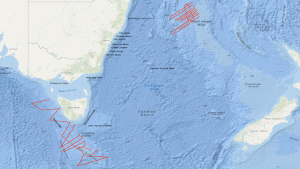On the first leg of SONNE cruise SO-36 in the period from 11th February to 12th March 1985, geophysical investigations have been carried out on the Lord Howe Rise off eastern Australia by the Federal Institute for Geosciences and Natural Resources (BGR) in co-operation with the Bureau of Mineral Resources, Geology and Geophysics, Canberra. A total of 3,660 km of digital seismic reflection profiles, 6,740 km of gravity, magnetics, multibeam echosounder and sub-bottom profiler profiles, as well as 8 sonobuoy refraction profiles were recorded during this survey. A geomagnetic monitoring station of the BGR was operated during a part of the cruise on Lord Howe Island under the supervision of the BMR. These measurements provided a detailed picture of the structures of the survey area of the Lord Howe Rise. The samples proved that the Lord Howe Rise and the Dampier Ridge west of it consist of continental crust. Indications for structures rich in hydrocarbons were not observed. The 2nd and 3rd leg of SONNE cruise SO-36 were designed to investigate the structure, geological development and hydrocarbon potential of two frontier areas, the western and southwestern continental margin of Tasmania and the South Tasman Rise. On the 2nd leg (12.03.-12.04.1985) multichannel seismic reflection measurements were carried out in parallel with magnetic, gravimetric, sea-beam and 3.5 kHz subbottom profiler measurements on 19 lines with a total length of 3,820 km. In addition, 2,140 km were surveyed with magnetics, gravity meter, sea-beam and 3.5 kHz subbottom profiler in transit from and to Sydney, respectively. On the 3rd leg, which started in Sydney on 12th April 1985 and ended in Suva/Fiji one month later, 63 stations were sampled by dredging and coring with the aim (a) to provide lithology and biostratigraphic information about the seismic sequences mapped during leg 2, and (b) to obtain geochemical evidence of hydrocarbon generation from the character of gases absorbed onto the surficial sediment. Samples came from 33 stations off Western Tasmania, from 23 stations on the South Tasman Rise, and from 7 stations in the region of the Lord Howe Rise and the Dampier Ridge. In transit to the sampling sites, 11 single channel seismic lines with a total length of 470 km were surveyed, and in addition, 4,230 km were surveyed with magnetics, gravity meter, sea-beam, and subbottom profiler. Seven regional seismic unconformities were recognized and sampled, and the structural style of both areas was established. Thermogenic hydrocarbons in substantial concentration were found in the surface sediments at the western Tasmanian slope. Auf dem 1. Fahrtabschnitt der SONNE Fahrt SO-36 vom 11. Februar bis zum 12. März 1985 sollten durch geophysikalische Messungen der geologische Bau und das Kohlenwasserstoffpotential eines Teilgebietes des Lord-Howe-Rückens untersucht werden. Auf dem 3. Fahrtabschnitt sollten die Ergebnisse durch geologische und geochemische Beprobungen ergänzt werden. Insgesamt wurden 3.660 km reflexionsseismisch sowie 6.740 km km mit Gravimetrie, Magnetik, Sea Beam und 3,5-kHz-Echograph vermessen. Für das Untersuchungsgebiet auf dem Lord-Howe-Rücken wurde ein detailliertes Bild der Strukturen erstellt. Durch die Beprobung konnte nachgewiesen werden, dass sowohl der Lord-Howe-Rücken als auch der westlich vorgelagerte Dampier-Rücken kontinentale Kruste haben. Indikationen für kohlenwasserstoffreiche Strukturen wurden nicht gefunden. Auf dem 2. und 3. Fahrtabschnitt der SONNE-Fahrt SO-36 (12.03.-12.04. bzw. 13.04.-12.05.1985) sollten mit Hilfe geophysikalischer Messungen und geologisch-geochemischer Studien der geologische Bau und das Kohlenwasserstoff-Potential des Kontinentalrandes von West Tasmania und des Süd-Tasman-Rückens untersucht werden. Profile mit einer Gesamtlänge von 4.290 km sind reflexionsseismisch erkundet worden, 10.660 km sind magnetisch, gravimetrisch und mit Seabeam sowie dem 3.5 kHz Sedimentechograph vermessen worden. Auf 63 Stationen sind geologisch-geochemische Studien durchgeführt worden. Sieben regionale Schichtlücken sind nachgewiesen worden. Der geologische Baustil beider Gebiete konnte in groben Zügen geklärt werden. Thermogene Kohlenwasserstoffe in beachtlicher Konzentration sind in den meeresbodennahen Sedimenten des Kontinentalabhanges von West Tasmania nachgewiesen worden.





